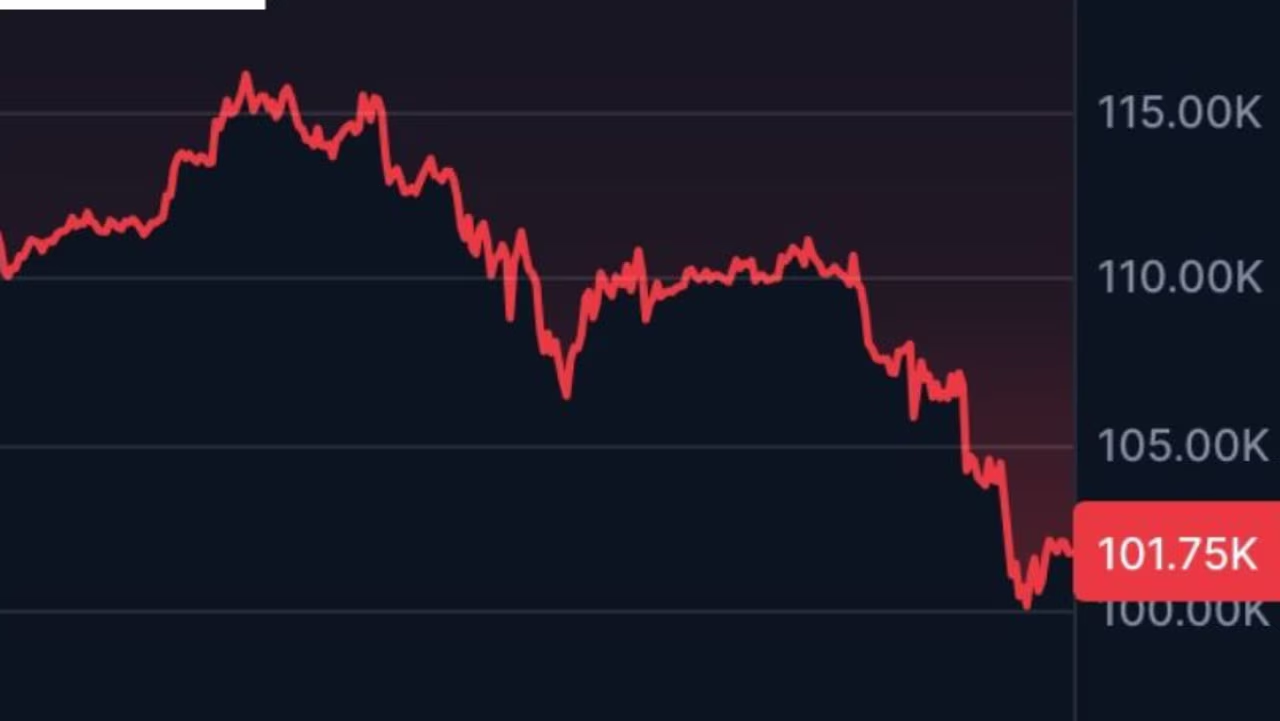Total panic as sellers unload $64b Bitcoin

Crypto investors are weathering a brutal storm this week as Bitcoin plunged through the US$100,000 (A$154,000) mark, reaching its lowest point in about four months.
On Wednesday, it passed below the dreaded six figure mark, trading as low as around US$99,500 (A$153,323) before rebounding to roughly A$154,300.
The fall comes amid a broader risk-off mood in markets, with tech equities under pressure, the US dollar strengthening, and investors pulling back from higher-volatility assets.
Trading platforms are predictably calling for calm, as analysts point to several key factors that contributed to the brief downturn. Some say the US Federal Reserve’s signal that rate cuts may not arrive soon has weakened the appeal of risky assets, while others say a stronger US dollar is weighing on non-yielding assets like Bitcoin.
Broader equity weakness and valuation concerns are also potentially spilling over into crypto markets.
Head of Sales at digital-asset trading firm Zerocap Mark Hiriart says the recent drop “tests the psychological US$100K support level” and represents a “four-month low.”
With the worrying drop, leveraged positions were likely liquidated, which in turn ramped up volatility.
Hiriart views this as part of a normal market cycle rather than a breakdown.
“From a Zerocap lens, this feels like the ‘shake-out’ phase of the bull market; dips like this have historically been buy opportunities for long-term holders,” he said.
“On-chain data shows accumulation picking up at these levels, and historical bounces from 50-week EMAs (near US$98K –$102K) suggest resilience.
“We’re not calling a capitulation yet, but position sizing is crucial … In volatile drawdowns like this, discipline is paramount … For those trying to play this market, it would be prudent to de-risk position sizes and be very strict with any stop losses.”
He also places the move in a historical context.
“Historically, November has been BTC’s strongest month … this ‘healthy correction’ (down about 9–10 per cent from the US$110,000 peak) aligns with patterns seen in prior cycles … At Zerocap, we’re viewing this as a rebalancing rather than a structural break, though vigilance on Fed liquidity signals remains key.”
Is it time to panic?
While seasoned investors like Zerocap’s Mark Hiriart frame the latest move as a “shake-out” rather than a collapse, parts of the market are clearly showing signs of panic.
According to several industry data providers, short-term holders and leveraged traders have been hit hardest, leading to forced liquidations and capitulation selling.
Reports indicate that crypto’s “OG whales”, which generally means large, long-time Bitcoin holders, have sold roughly US$41.6 billion (A$64 billion) worth of Bitcoin during the recent weakness.
At the same time, on-chain data shows short-term traders have realised losses exceeding US$3 billion (A$4.6 billion) as stop-losses triggered across major exchanges.
Analysts at Cointelegraph describe this as “panic-selling” driven by automated liquidations and sentiment shock rather than structural failure.
Some of the more alarmed voices in the market warn that the breach of the US$100,000 (A$154,000) level could accelerate a deeper correction.
One bearish analyst quoted by Investing.com said, “If long-term holders continue to offload at this pace, the market could see an uncontrolled unwind down to US$80,000 (A$123,000) or even the mid-US$70,000s (A$108,000).”
Another report noted that nearly 400,000 BTC have been moved out of long-term wallets in the past month — a level of activity typically associated with fear phases in previous cycles.
But not all data supports the notion of total panic.
Some institutional traders are quietly accumulating, betting that this correction will prove short-lived.
As one analyst told CoinDesk, “This is fear, yes, but not capitulation. Retail is spooked, leverage is flushed, and stronger hands are waiting below.”
Markets feel the heat
The bitcoin tumble coincided with a tech spiral as several companies led a sharp sell-off across Asia on Wednesday as investors grow increasingly worried about an AI bubble following a rally this year that has seen valuations hit record highs.
Global markets have soared this year as an eye-watering flood of cash piled into companies linked to artificial intelligence, including US titans Nvidia, Amazon and Apple as well as Asian firms Samsung and Alibaba.
But despite strong earnings releases in recent quarters, traders have started questioning the wisdom of chasing ever-higher prices, with cash mostly funnelled into a handful of big-name companies.
The gains have also been helped by an easing of US trade tensions and expectations that the Federal Reserve will continue to cut interest rates into the new year.
But last week’s warning from the US central bank that another reduction in December was not a foregone conclusion jolted sentiment.
After an uncertain start to the week Monday, Wall Street tumbled on Tuesday, with the tech-rich Nasdaq down more than two per cent and the S&P 500 off more than one per cent.
US software firm Palantir slumped 8.0 per cent despite reporting a 63 per cent surge in revenues and profits.
Asia took up the baton in the morning, with Seoul and Tokyo the hardest hit, having just hit record highs.
Seoul tanked six per cent at one point, as chip giants Samsung and SK hynix each lost around seven per cent.





